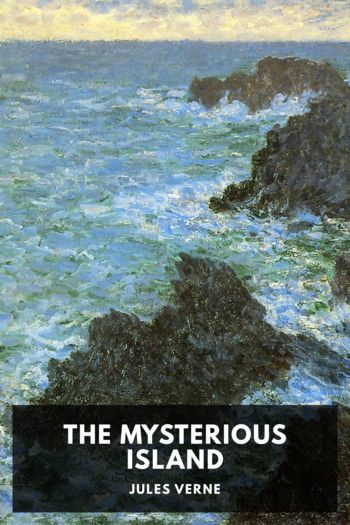An Antarctic Mystery, Jules Verne [ereader that reads to you TXT] 📗

- Author: Jules Verne
Book online «An Antarctic Mystery, Jules Verne [ereader that reads to you TXT] 📗». Author Jules Verne
And under these lines was a name, a signature, the name of Patterson!
Then I remembered! Patterson was the second officer of the Jane, the mate of that schooner which had picked up Arthur Pym and Dirk Peters on the wreck of the Grampus, the Jane having reached Tsalal Island; the Jane which was attacked by natives and blown up in the midst of those waters.
So then it was all true? Edgar Poe’s work was that of an historian, not a writer of romance? Arthur Gordon Pym’s journal had actually been confided to him! Direct relations had been established between them! Arthur Pym existed, or rather he had existed, he was a real being! And he had died, by a sudden and deplorable death under circumstances not revealed before he had completed the narrative of his extraordinary voyage. And what parallel had he reached on leaving Tsalal Island with his companion, Dirk Peters, and how had both of them been restored to their native land, America?
I thought my head was turning, that I was going mad—I who accused Captain Guy of being insane! No! I had not heard aright! I had misunderstood! This was a mere phantom of my fancy!
And yet, how was I to reject the evidence found on the body of the mate of the Jane, that Patterson whose words were supported by ascertained dates? And above all, how could I retain a doubt, after James West, who was the most self-possessed among us, had succeeded in deciphering the following fragments of sentences:—
“Drifting since the 3rd of June north of Tsalal Island … Still there … Captain William Guy and five of the men of the Jane—the piece of ice I am on is drifting across the iceberg … food will soon fail me … Since the 13th of June … my last resources exhausted … today … 16th of June … I am going to die.”
So then for nearly three months Patterson’s body had lain on the surface of this ice-waif which we had met on our way from the Kerguelens to Tristan d’Acunha! Ah! why had we not saved the mate of the Jane!
I had to yield to evidence. Captain Len Guy, who knew Patterson, had recognized him in this frozen corpse! It was indeed he who accompanied the captain of the Jane when he had interred that bottle, containing the letter which I had refused to believe authentic, at the Kerguelens. Yes! for eleven years, the survivors of the English schooner had been cast away there without any hope of succour.
Len Guy turned to me and said, “Do you believe—now?”
“I believe,” said I, falteringly; “but Captain William Guy of the Jane, and Captain Len Guy of the Halbrane—”
“Are brothers!” he cried in a loud voice, which was heard by all the crew.
Then we turned our eyes once more to the place where the lump of ice had been floating; but the double influence of the solar rays and the waters in this latitude had produced its effect, no trace of the dead man’s last refuge remained on the surface of the sea.
VII Tristan d’AcunhaFour days later, the Halbrane neared that curious island of Tristan d’Acunha, which may be described as the big boiler of the African seas. By that time I had come to realize that the “hallucination” of Captain Len Guy was a truth, and that he and the captain of the Jane (also a reality) were connected with each other by this ocean waif from the authentic expedition of Arthur Pym. My last doubts were buried in the depths of the ocean with the body of Patterson.
And now, what was Captain Len Guy going to do? There was not a shadow of doubt on that point. He would take the Halbrane to Tsalal Island, as marked upon Patterson’s notebook. His lieutenant, James West, would go whithersoever he was ordered to go; his crew would not hesitate to follow him, and would not be stopped by any fear of passing the limits assigned to human power, for the soul of their captain and the strength of their lieutenant would be in them.
This, then, was the reason why Captain Len Guy refused to take passengers on board his ship, and why he had told me that his routes never were certain; he was always hoping that an opportunity for venturing into the sea of ice might arise. Who could tell indeed, whether he would not have sailed for the south at once without putting in at Tristan d’Acunha, if he had not wanted water? After what I had said before I went on board the Halbrane, I should have had no right to insist on his proceeding to the island for the sole purpose of putting me ashore. But a supply of water was indispensable, and besides, it might be possible there to put the schooner in a condition to contend with the icebergs and gain the open sea—since open it was beyond the eighty-second parallel—in fact to attempt what Lieutenant Wilkes of the American Navy was then attempting.
The navigators knew at this period, that from the middle of November to the beginning of March was the limit during which some success might be looked for. The temperature is more bearable then, storms are less frequent, the icebergs break loose from the mass, the ice wall has holes in it, and perpetual day reigns in that distant region.
Tristan d’Acunha lies to the south of the zone of the regular southwest winds. Its climate is mild and moist. The prevailing winds are west and northwest, and, during the winter—August and September—south. The island was inhabited, from 1811, by American whale fishers. After them, English soldiers were installed there to watch





Comments (0)